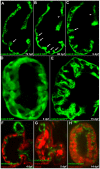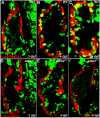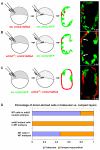A dual role for ErbB2 signaling in cardiac trabeculation
- PMID: 20978078
- PMCID: PMC3049280
- DOI: 10.1242/dev.053736
A dual role for ErbB2 signaling in cardiac trabeculation
Abstract
Cardiac trabeculation is a crucial morphogenetic process by which clusters of ventricular cardiomyocytes extrude and expand into the cardiac jelly to form sheet-like projections. Although it has been suggested that cardiac trabeculae enhance cardiac contractility and intra-ventricular conduction, their exact function in heart development has not been directly addressed. We found that in zebrafish erbb2 mutants, which we show completely lack cardiac trabeculae, cardiac function is significantly compromised, with mutant hearts exhibiting decreased fractional shortening and an immature conduction pattern. To begin to elucidate the cellular mechanisms of ErbB2 function in cardiac trabeculation, we analyzed erbb2 mutant hearts more closely and found that loss of ErbB2 activity resulted in a complete absence of cardiomyocyte proliferation during trabeculation stages. In addition, based on data obtained from proliferation, lineage tracing and transplantation studies, we propose that cardiac trabeculation is initiated by directional cardiomyocyte migration rather than oriented cell division, and that ErbB2 cell-autonomously regulates this process.
Figures







Similar articles
-
The zinc finger protein Zfpm1 modulates ventricular trabeculation through Neuregulin-ErbB signalling.Dev Biol. 2019 Feb 15;446(2):142-150. doi: 10.1016/j.ydbio.2019.01.001. Epub 2019 Jan 3. Dev Biol. 2019. PMID: 30611731
-
Coordinating cardiomyocyte interactions to direct ventricular chamber morphogenesis.Nature. 2016 Jun 30;534(7609):700-4. doi: 10.1038/nature18310. Nature. 2016. PMID: 27357797 Free PMC article.
-
Metabolic modulation regulates cardiac wall morphogenesis in zebrafish.Elife. 2019 Dec 23;8:e50161. doi: 10.7554/eLife.50161. Elife. 2019. PMID: 31868165 Free PMC article.
-
Essential roles of Her2/erbB2 in cardiac development and function.Recent Prog Horm Res. 2004;59:1-12. doi: 10.1210/rp.59.1.1. Recent Prog Horm Res. 2004. PMID: 14749494 Review.
-
Mechanisms of Trabecular Formation and Specification During Cardiogenesis.Pediatr Cardiol. 2018 Aug;39(6):1082-1089. doi: 10.1007/s00246-018-1868-x. Epub 2018 Mar 28. Pediatr Cardiol. 2018. PMID: 29594501 Free PMC article. Review.
Cited by
-
SWI/SNF chromatin-remodeling complexes in cardiovascular development and disease.Cardiovasc Pathol. 2014 Mar-Apr;23(2):85-91. doi: 10.1016/j.carpath.2013.09.003. Epub 2013 Oct 4. Cardiovasc Pathol. 2014. PMID: 24183004 Free PMC article. Review.
-
Opposite effects of Activin type 2 receptor ligands on cardiomyocyte proliferation during development and repair.Nat Commun. 2017 Dec 1;8(1):1902. doi: 10.1038/s41467-017-01950-1. Nat Commun. 2017. PMID: 29196619 Free PMC article.
-
Heart development in two populations of Atlantic killifish (Fundulus heteroclitus) following exposure to a polycyclic aromatic hydrocarbon mixture.Ecotoxicol Environ Saf. 2021 Jan 15;208:111580. doi: 10.1016/j.ecoenv.2020.111580. Epub 2020 Nov 6. Ecotoxicol Environ Saf. 2021. PMID: 33396103 Free PMC article.
-
The ERBB2 c.1795C>T, p.Arg599Cys variant is associated with left ventricular outflow tract obstruction defects in humans.HGG Adv. 2025 Jul 10;6(3):100446. doi: 10.1016/j.xhgg.2025.100446. Epub 2025 May 5. HGG Adv. 2025. PMID: 40329538 Free PMC article.
-
Fluorescent-based methods for gene knockdown and functional cardiac imaging in zebrafish.Mol Biotechnol. 2013 Oct;55(2):131-42. doi: 10.1007/s12033-013-9664-6. Mol Biotechnol. 2013. PMID: 23674069 Free PMC article.
References
-
- Bartman T., Hove J. (2005). Mechanics and function in heart morphogenesis. Dev. Dyn. 233, 373-381 - PubMed
-
- Ben-Shachar G., Arcilla R. A., Lucas R. V., Manasek F. J. (1985). Ventricular trabeculations in the chick embryo heart and their contribution to ventricular and muscular septal development. Circ. Res. 57, 759-766 - PubMed
-
- Bersell K., Arab S., Haring B., Kuhn B. (2009). Neuregulin1/ErbB4 signaling induces cardiomyocyte proliferation and repair of heart injury. Cell 138, 257-270 - PubMed
-
- Busse D., Doughty R. S., Ramsey T. T., Russell W. E., Price J. O., Flanagan W. M., Shawver L. K., Arteaga C. L. (2000). Reversible G(1) arrest induced by inhibition of the epidermal growth factor receptor tyrosine kinase requires up-regulation of p27(KIP1) independent of MAPK activity. J. Biol. Chem. 275, 6987-6995 - PubMed
Publication types
MeSH terms
Substances
Grants and funding
LinkOut - more resources
Full Text Sources
Molecular Biology Databases
Research Materials
Miscellaneous

